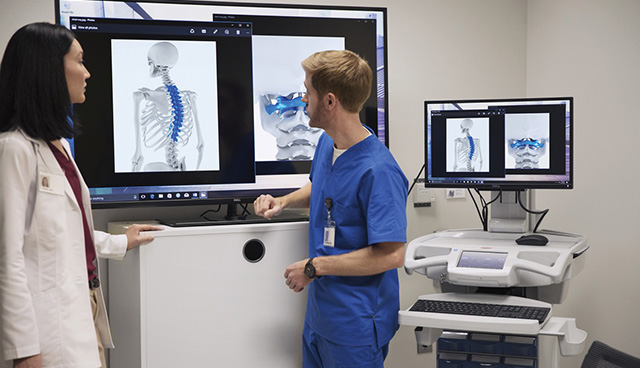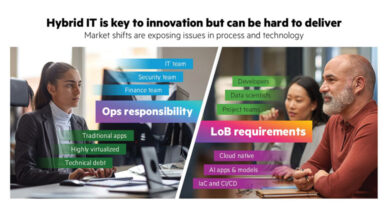Accelerate innovation with health IT transformation


The health service in Ireland is under pressure to transform, and quickly. James Norman, Healthcare CIO – Europe & Middle East Africa, at Dell EMC, writes.
With the total number of citizens waiting for treatment and appointments now exceeding 707,000, Clinicians and IT teams need to look beyond replicating existing services, pathways and clinical practices and work together to determine how technology can play a central role from the outset to achieve a step change in service delivery and efficiency.
Changing how healthcare approaches digital transformation and the role of technology will fundamentally transform the delivery of healthcare. For example, we estimate that the use of data analytics would improve the efficiency of the healthcare sector by between 15 per cent and 60 per cent. IDC reports that by 2019, digitisation of healthcare with applications incorporating analytics and intelligence within, can save as much as 30 per cent of clinician’s time.
With over 55 per cent of citizens wanting online services in healthcare, the Government needs to show that it is listening and providing the types and levels of service that we’re now so used to from other areas of our lives, such as banking and retail. Today’s ‘information generation’ have demanding requirements of the businesses from which they choose to buy products and services and they expect the same from the health services. Citizens and patients want 24/7 access and a more unique and personalised experience.
We have seen in recent times a clearer vision underpinned by the Sláintecare Plan and commitment across public and private healthcare providers to shift care from hospitals and into primary and community settings. This Shift Left strategy will alleviate the pressures on our hospital system and deliver care closer to home, at lower cost with better outcomes. The Sláintecare Plan is a crucial, critical first step in ensuring that any transformation project has a clear set of objectives that will benefit all aspects of the health economy.
Perhaps the biggest challenge is this change in mindset. Sláintecare’s 10-year €2.6 billion budget, combined with a once-off capital spend of €3 billion will require healthcare organisations need to see their IT as a vehicle for change and transformation, taking inspiration from other sectors that are already experiencing the benefits that it can bring, such as manufacturing, retail and financial services.
We know that the ‘one-size-fits-all’ approach to IT deployments that has been taken in the past doesn’t work – healthcare organisations need the freedom and flexibility to make decisions based on their specific requirements. However, this doesn’t need to mean reinventing the wheel in every hospital, GP surgery and community care setting. We need a ‘translational’ approach where organisations share innovation, adopt what’s working well in other places, shape it to their own needs and adapt to new ways of working.
There are five key steps that should be considered in order to enable the above:
Step 1: Create a vision and culture of collaboration
Many organisations have traditionally worked in a siloed way, bounded by narrow budget lines. That approach needs to change, and quickly, if they are to truly transform from a slow, rigid and old-fashioned environment to one that is flexible, innovative and collaborative. Leaders need to encourage a change in culture throughout the organisation that is focused on strong collaboration; moving away from traditional silos and working together towards clear goals.
Step 2: Invest in people and technologies that enable collaboration and transformation
The role that technology plays in realising effective collaboration and transformation should no longer be an afterthought, but rather it needs to be seen as the enabler and partner to all change. This means putting in place underpinning technology that supports business processes and takes advantage of all the data now available at our fingertips. What is needed is a common technology platform which existing services can plug into and where data can be shared seamlessly, with analytical capabilities to interpret the data, extract insights and deliver benefits.
Step 3: Support the culture change that is an inevitable part of any technology transformation
Transforming pathways, working practices and supporting patients in a way that will lead to improvement in quality, service and outcomes achieved will also need careful design. Managing the change well will mean working alongside clinical and managerial teams to help them understand what specific changes need to take place in their practices and roles. This could mean stopping some things and starting others but will almost certainly include reshaping elements of the workforce such as job design and content as the programme moves forward. All of these are key reasons for failure – its complex, hard work and additional to the day job.
Successful change management is about anticipating this and upskilling employees and teams where needed to help re-shape the future.
“The Sláintecare Plan is a crucial, critical first step in ensuring that any transformation project has a clear set of objectives that will benefit all aspects of the health economy.”
4: Work with patients on the change programme
Changing the script for health and social care as we know it means changing mindsets and behaviours in the public sphere, not just among the professionals. As indicated earlier, there is already considerable interest and buy-in from the public to be even more engaged. This needs to be built into the collaborative leadership agenda of an organisation. Develop an engagement programme that incorporates ideas from them and they’re more likely to buy into the process.
Step 5. Use the Data
One of the most important developments in the last 30 years has been the power of technology to handle increasingly complex data. The short-term benefits of technology platforms to help us improve our communication and ways of working is eclipsed by the future gain of data analytics. For example, better and more informed use of technology could improve the treatment of disease in the future. The targeted use of treatment, such as in stratified medicine approaches, enables us to customise drug treatment and doses to specific DNA profiles, rather than the current methods which focus largely on historical practices of prescribing against age, weight and gender.
System and organisational leaders need to consider at the outset how they will harvest data, analyse it and make use of it. In many cases, new technology fails to make its impact because we have not changed the policies within organisations that will be needed to support its use. Data access, cybersecurity and on-going compliance rules will need to be considered and addressed. But, none of this should become a barrier to us gaining the full potential of better data analytics such as improved treatments for cancer, heart disease and a host of others.
Putting the patient at the centre, getting clinical staff buy-in and helping people move toward new ways of working is key. The aim of reducing service demand, increasing independence within populations and creating more sustainable and affordable systems for the future is a shared enterprise. Leadership, collaboration and change management skills are essential if we are to exploit the potential value of technology.
If you are to take away just one point from reading this, it should be that to take Sláintecare and the Irish healthcare system forward and make it a successful, innovative institution, means full organisational transformation. Technology is an essential enabler and driver of solutions, but it is not the reason for the change itself.
For more information please contact: E: Fergal.Murray@dell.com






